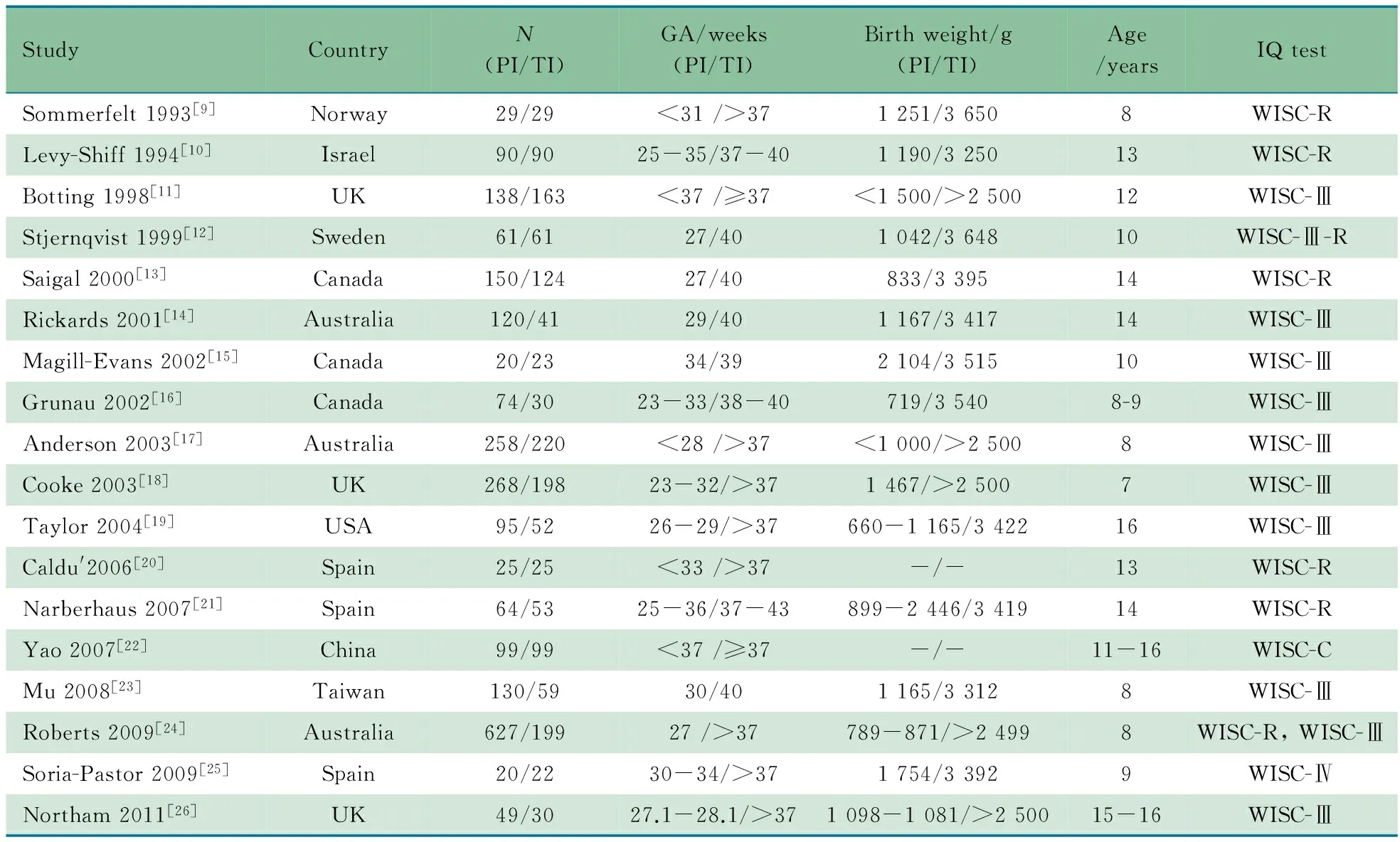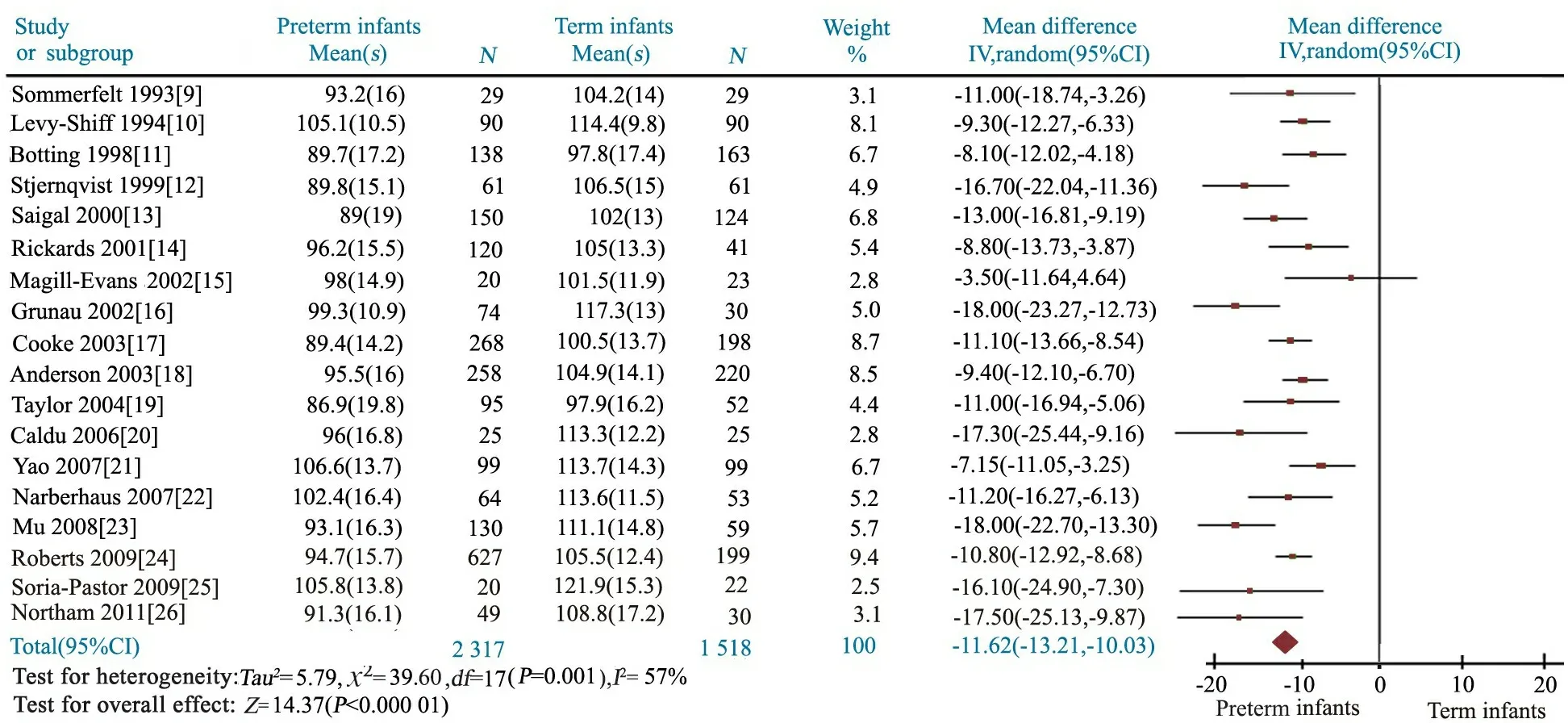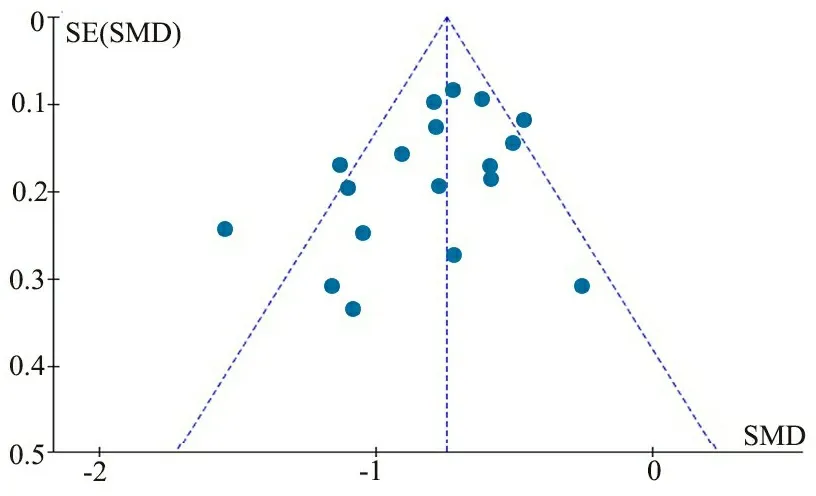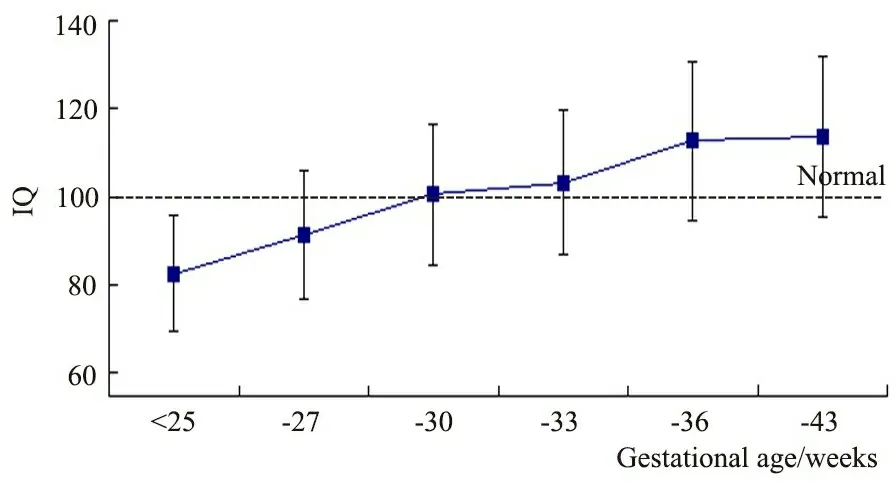系统评价早产对儿童智力发育的影响及早期干预作用
余章斌 韩树萍 邱玉芳 董小玥 郭锡熔
随着产科和新生儿重症监护技术的快速发展,早产儿的存活率不断提高,但早产儿神经系统的后遗症(如智力低下、脑瘫等)发生率也随之增高。研究表明早产儿智力低下的发生率为7.8%,平均智力水平也明显低于足月儿[1];一项江苏省7个城市的新生儿流行病学调查表明,早产儿胎龄越小其智力水平越差[2]。有Meta分析表明早产儿在学龄期有更低的认知测验得分,发生多动症的概率明显增加[3];另外1篇Meta分析表明早产儿在学龄期学习能力欠佳、注意力不集中和学习执行能力差[4]。但上述Meta分析均没有对早产儿的智力水平进行评价,本文采用Meta分析的方法评价早产对其智力的影响,使临床工作者对此得以认识与重视。
认识到早产儿行为、认知、智力等方面明显落后于足月儿,对其早期干预显得迫在眉睫。但由于早产儿有不同于足月儿的特殊生理和病理状态,因此,进行早期干预的生理基础及方式方法都有其特点,针对这些特点,国内外的专家学者进行了大量的临床研究并对这些研究进行系统评价[5,6],结果表明早期干预可以改善早产儿近期(学龄前期)的生长发育,但对于早产儿远期(学龄期)的生长发育并没有明显效果。但有学者认为早期干预的作用不明显[7],考虑到早产儿早期干预研究的Meta分析发表已有2年多,有必要再次检索相关文献,对早产儿早期干预对智力发育的作用再进行评价。
1 方法
1.1 纳入、排除标准及观察指标
1.1.1 早产与儿童智力发育 纳入临床对照研究,试验组为早产、低出生体重儿(胎龄<37周,出生体重<2 500 g);对照组为同年龄的足月儿(胎龄≥37周,出生体重≥2 500 g)。采用韦氏儿童智力量表(WISC)对6~16岁儿童进行智力检测,结果以智商(IQ)表示;不能提取IQ结果进行合并分析的研究予以排除。
1.1.2 早产儿早期干预与智力心理发育 纳入早期干预早产儿(胎龄<37周,出生体重<2 500 g)的半随机对照试验(quasi-RCT)或RCT;试验组采用早期干预的方法,对照组采用常规的方法;各组婴儿(早产儿纠正年龄)于生后6、12、18、24、36个月采用贝利婴儿发育量表(BSID)测定婴幼儿智力发育指数(MDI),心理运动发育指数(PDI),MDI及PDI ≥80 分为智力正常,MDI及PDI <80 分为智力异常;不能提取MDI或PDI结果进行合并分析的研究予以排除。
1.2 文献检索策略
1.2.1 数据库 Cochrane图书馆(2011年第11期)的临床对照试验中心资料库(CENIRAL)、PubMed、EMBASE、万方数据库、中国期刊全文数据库和中国维普数据库,检索文献起止时间均从1980年1月起至2011年11月。
1.2.2 检索策略 均采用计算机检索,未手工检索灰色文献。
1.2.2.1 早产与儿童智力发育 英文检索式:(intelligence quotients OR IQ OR intelligence) AND(premature infant OR very low birth weight infants OR VLBWI OR extremely low birth weight infants OR ELBWI); 中文检索式:(智力 OR 智商)AND(早产儿 OR 极低出生体重儿 OR 超低出生体重儿)。
1.2.2.2 早产儿早期干预 英文检索式:(early intervention OR infant stimulation) AND(premature infant OR very low birth weight infants OR VLBWI OR extremely low birth weight infants OR ELBWI); 中文检索式:(早期干预 OR 婴儿刺激)AND(早产儿 OR 极低出生体重儿 OR 超低出生体重儿)。
1.3 文献质量评价方法
1.3.1 纳入和排除文献方法 由邱玉芳、董小玥按照检索策略独立完成初步检索,各自独立阅读文题和摘要,筛选符合条件的文献,独立摘录每一项研究的信息结果,同时对入选文献的设计、实施和分析过程进行再评价。如果2名评价者对评价结果有分歧,则由余章斌评价决定。
1.3.2 资料提取 包括研究的基本情况、样本量、受试者特征及结果,疗效判定指标的结果。
1.3.3 文献质量评估 文献评价由邱玉芳、董小玥独立进行,如有不同意见通过讨论或提请余章斌裁定。采用Cochrane Handbook for Systematic Reviews of Interventions 5.0.2 的6项质量评价标准进行评价[8]。针对每一篇文献,对6项标准作出“是”、“否”和“不清楚”(缺乏相关信息或偏倚情况不确定)的判断。如试验报告的资料难以使用,将进一步与试验的主要研究者联系获取。全部6项标准均充分正确者为低度偏倚风险,1项描述不清为中度偏倚风险,2项及以上不满足为高度偏倚风险。
1.4 统计学方法 采用RevMan 5.0.13软件进行Meta分析,将资料进行定量综合。首先对纳入研究进行异质性分析,采用χ2检验,P≥0.1为研究间具有同质性,采用固定效应模型描述,P<0.1为研究间具有异质性,采用随机效应模型表达。计量资料选取加权均数差(WMD)及其95%CI表示,计数资料选取OR及其95%CI表示,P<0.05为差异有统计学意义。采用漏斗图检验是否存在发表偏倚。必要时剔除低质量文献进行敏感性分析。
2 结果
2.1 一般情况 文献选择流程见图1。共检索到82篇早产与儿童智力的文献,通过阅读摘要,26篇文献被初步纳入,进一步阅读全文,最终纳入18项研究[9~26],其中中国研究1项,其他国家研究17项(表1)。共检索到63篇早产儿早期干预的文献,通过阅读摘要,23篇文献被初步纳入,进一步阅读全文,最终纳入15项研究(16篇文献)[27~42],其中中国研究6项,其他国家研究9项(表2)。

图1 文献选择流程图
Fig 1 Flow chart of article screening and selection process
2.2 文献偏倚评价 对早产儿早期干预文献的偏倚评价结果显示,9项研究[27,28,30~32,36,39~42]提及随机分配方法;9项研究[27~30,32,36,39~42]提及分配方案隐藏;9项研究[27,28,30,32,34,36,39~42]提及对研究对象、治疗方案实施者、研究结果测量者采用盲法;12项研究[27,28,31~33,35~42]提及结果数据的完整性;10项研究[27~29,31,32,34,36,39~42]提及选择性报告研究结果;没有文献提及其他偏倚来源。7项研究[27,28,32,36,39~42]存在中度偏倚风险,8项研究[29~31,33~35,37,38]存在高度偏倚风险。
2.3 早产与儿童智力发育 有18篇文献比较了早产儿和足月儿的IQ,异质性检验P<0.1,表明结果具有异质性,采用随机效应模型。早产儿IQ明显低于足月儿(SMD=-11.62,95%CI: -13.21~-10.03),Z=14.37,P<0.001(图2)。早产与儿童智力发育文献的漏斗图分析显示不存在发表偏倚(图3)。
对胎龄与IQ的关系进行分层分析,发现胎龄越低,IQ越低,儿童期随访,IQ从胎龄34~36周的112.7逐渐降至胎龄25周的82.1(图4)。

表1 早产与儿童智力发育纳入文献的基本情况
Notes PI/TI: preterm infants/term infants;GA:gestational age

表2 早产儿早期干预纳入文献的基本情况
Notes I/C: intervention/control; GA:gestational age;IHDP: infant health and development program; MITP: mother-infant transaction program; IBAIP: infant behavioral assessment and intervention program; PBIP: parent baby interaction program; EIPI: early intervention of premature infants; PFIP: parent-focused intervention program; MII: mother-infant interaction; EIP: early intervention program

图2 早产与儿童IQ的Meta分析
Fig 2 Meta-analysis of the effect of preterm birth on the intellectual development

图3 早产与儿童IQ文献发表偏倚的漏斗图
Fig 3 Funnel plot of the effect of preterm birth on the intellectual development

图4 不同胎龄早产儿对儿童IQ的影响
Fig 4 The effect of preterm birth with different GA on the intellectual development
2.4 早产儿早期干预对MDI、PDI和智力异常发生率的影响 15项研究对早产儿早期干预的作用进行了评价,各组(早产儿纠正年龄)于生后6、12、18、24、36个月测定MDI与PDI,结果表明早期干预组MDI与PDI均较对照组明显提高,差异有统计学意义,P均<0.001(表3,4)。
有5项研究[35~37,41,42]报道了早产儿早期干预对智力异常发生率的影响,异质性检验P=0.21,研究间具同质性,采用固定效应模型分析。Meta分析结果显示,早期干预能显著降低早产儿智力异常的发生率,OR= 0.25,95%CI: 0.15~0.41(Z=5.39,P<0.001)(图5)。

表3 早产儿早期干预对MDI影响的Meta分析

表4 早产儿早期干预对PDI影响的Meta分析

图5 早产儿早期干预对智力异常发生率影响的Meta分析
Fig 5 Meta-analysis of the effect of early intervention on mental abnormalities of preterm infants
2.5 敏感性分析 从表3、4和图5可见文献[37]样本量最大,但其为低质量文献,质量评价仅结果完整性1项充分准确,文献[37]在早产儿早期干预对智力发育影响的结论中所占权重可能影响本文结论,故剔除文献[37]行敏感性分析。结果表明早期干预组MDI与PDI均明显提高,P均<0.001,提示剔除文献[37]对结果没有影响。剔除文献[37]行早期干预与智力异常发生率的敏感性分析,异质性检验P=0.89,表明结果具有同质性,采用固定效应模型分析。Meta分析结果显示,早期干预可显著降低早产儿智力异常的发生率,OR= 0.41,95%CI: 0.22~0.76(Z=2.80,P=0.005),提示剔除文献[37]对结果没有影响。
3 讨论
来自美国的一项研究表明早产儿IQ比平均水平低10分,相当于增加6%~35%中学退学的机会[43]。本Meta分析表明早产儿IQ较足月儿明显降低,并随着胎龄的降低逐渐减低,尽管随着新生儿护理和救治水平的提高,早产儿成活率逐渐增加,但1993至2011年的观察性研究都没有表明早产儿的IQ也有升高趋势,因而,在提高早产儿救治水平的同时,需注意早产儿的智力发育预后。
针对早产儿的生理特点,国内外学者制定了一些早产儿早期干预的方法,如本文中纳入的美国实施的儿童健康和发展方案(IHDP)[28],通过家访为父母提供感情和社会支持,宣传关于低出生体重儿童的健康和发育知识,帮助父母提高解读婴儿信息方面的能力和支持;同时在儿童发展中心观察、实施和评估早产儿干预的效果,衡量儿童现在的功能水平,预测以后应实施的方案。该项目已经在美国8个城市开展,已经有985例早产儿及其家庭参与,取得了良好的效果。
鲍秀兰等[44]根据不同年龄和发育程度制定了0~3岁早期教育教学大纲,内容包括运动发育、认知能力、语言发育和社会交往能力。本Meta分析纳入的5篇国内研究,均采用鲍秀兰的早期教育教学大纲早期干预早产儿,收到了良好的效果。同时鲍秀兰成立早期干预降低早产儿脑瘫发生率研究协作组,对29个单位1 390例早产儿进行早期干预,与1 294例常规育儿组比较,可以明显减少脑瘫发生率(OR=3.90; 95%CI: 2.10~7.26),提示早期干预措施对于高危早产儿有促进发育的作用,值得推广应用。本Meta分析也表明早期干预可以降低智力异常发生率,因而,现有结果支持早期干预减少早产儿神经系统后遗症(如智力低下、脑瘫等)的发生率。
本Meta分析结果提示早期干预可提高6、12、18和24月龄的MDI和PDI,但在36月龄随访时表明早期干预对MDI和PDI没有显著影响,考虑随访到36月龄时仅纳入2篇文献,样本量较少(123例),容易产生偏移。2篇文献[28,45]分别采用McCarthy and Stanford-Binet方法评价早期干预对早产儿36月龄IQ影响,表明早期干预取得阳性的结果(WMD=9.66,95%CI:5.01~14.31)。因而早期干预对36月龄时IQ的影响仍需要加大样本量进行评价。有研究[46,47]在5、8和18岁随访早期干预对早产儿的智力作用,并没有观察到在6、12、18和24月龄随访时较显著的影响结果,一方面考虑5、8和18岁随访研究较少,样本量较少易产生偏移;另一方面考虑早期干预的实施持续时间对儿童远期IQ的影响不确定,这需要进一步的研究评价。
本Meta分析结果表明,IQ水平随胎龄降低而降低,胎龄>33周组IQ虽然低于足月儿水平,但处于正常水平。而胎龄<33周组IQ不仅低于足月儿,且低于正常水平,结合Aarnoudse-Moens等[4]研究表明胎龄<33周对早产儿神经系统发育的影响较大,本文纳入2000年后国外发表文献早产儿的干预胎龄均在30周左右,而中国胎龄<30周存活早产儿较少,而30~33周早产儿是救治存活并随访神经系统发育滞后的主要人群,是干预的重点人群,早期干预对其IQ的改善效果更明显。
本Meta分析存在的不足和局限性:① 早期干预对早产儿智力影响的研究较少,特别是随着随访时间的延长,纳入研究越来越少,因而早期干预对远期智力影响的评价目前存在争议,需要更长期的随访研究。 ② 纳入文献总体质量不高,7项研究存在中度偏倚风险,8项研究存在高度偏倚风险;有10项研究未对研究对象、治疗方案实施者和研究结果测量者采用盲法,可能存在一定的实施和测量偏倚。③ 本文纳入的研究分别来自7个不同国家,其中中国干预性研究较多,文献质量明显低于西方国家,同时这些研究随访时间较短,没有长期随访研究报道。
总之,本Meta分析表明早产儿IQ明显低于足月儿,并随着胎龄的降低而逐渐减低;对早产儿早期干预可以明显改善早产儿智力水平,减少智力异常的发生率。
[1]Zhao SM(赵时敏). Strengthen the prevention and treatment of complications to improve the survival rate and quality of life in preterm infants. Chin J Pediatr(中华儿科杂志),2003,41(2):81-83
[2]Lin Q(林庆),Li S,Liu JM,et al. Cerebral palsy in seven cities of Jiangsu province. Chin J Pediatr(中华儿科杂志),1999,37(1):42-44
[3]Bhutta AT,Cleves MA,Casey PH,et al. Cognitive and beha-vioral outcomes of school-aged children who were born preterm: a meta-analysis. JAMA,2002,288(6):728-737
[4]Aarnoudse-Moens CS,Weisglas-Kuperus N,van Goudoever JB,et al. Meta-analysis of neurobehavioral outcomes in very preterm and/or very low birth weight children. Pediatrics,2009,124(2):717-728
[5]Spittle AJ,Orton J,Doyle LW,et al. Early developmental intervention programs post hospital discharge to prevent motor and cognitive impairments in preterm infants. Cochrane Database Syst Rev,2007,2:CD005495
[6]Orton J,Spittle A,Doyle L,et al. Do early intervention pro-grammes improve cognitive and motor outcomes for preterm infants after discharge? A systematic review. Dev Med Child Neurol,2009,51(11):851-859
[7]Clements KM,Barfield WD,Ayadi MF,et al. Preterm birth-associated cost of early intervention services: an analysis by gestational age. Pediatrics,2007,119(4):866-874
[8]Higgins JPT,Green S. Cochrane Handbook for Systematic Reviews of Interventions Version 5.1.0 [updated March 2011]. The Cochrane Collaboration,2011. Available from www.cochrane-handbook.org
[9]Sommerfelt K,Ellertsen B,Markestad T. Personality and beha-viour in eight-year-old,non-handicapped children with birth weight under 1500 g. Acta Paediatr,1993,82(9):723-728
[10]Levy-Shiff R,Einat G,Mogilner MB,et al. Biological and environmental correlates of developmental outcome of prema-turely born infants in early adolescence. J Pediatr Psychol,1994,19(1):63-78
[11]Botting N,Powls A,Cooke RW,et al. Cognitive and edu-cational outcome of very-low-birthweight children in early adolescence. Dev Med Child Neurol,1998,40(10):652-660
[12]Stjernqvist K,Svenningsen NW. Ten-year follow-up of children born before 29 gestational weeks: health,cognitive develop-ment,behaviour and school achievement. Acta Paediatr,1999,88(5):557-562
[13]Saigal S,Hoult LA,Streiner DL,et al. School difficulties at adolescence in a regional cohort of children who were extremely low birth weight. Pediatrics,2000,105(2):325-331
[14]Rickards AL,Kelly EA,Doyle LW,et al. Cognition,academic progress,behavior and self-concept at 14 years of very low birth weight children. J Dev Behav Pediatr,2001,22(1):11-18
[15]Magill-Evans J,Harrison MJ,Van der Zalm J,et al. Cognitive and language development of healthy preterm infants at 10 years of age. Phys Occup Ther Pediatr,2002,22(1):41-56
[16]Grunau RE,Whitfield MF,Davis C. Pattern of learning disabilities in children with extremely low birth weight and broadly average intelligence. Arch Pediatr Adolesc Med,2002,156(6):615-620
[17]Anderson P,Doyle LW. Neurobehavioral outcomes of school-age children born extremely low birth weight or very preterm in the 1990s. JAMA,2003,289(24):3264-3272
[18]Cooke RW,Foulder-Hughes L. Growth impairment in the very preterm and cognitive and motor performance at 7 years. Arch Dis Child,2003,88(6):482-487
[19]Taylor HG,Minich N,Bangert B,et al. Long-term neuropsy-chological outcomes of very low birth weight: associations with early risks for periventricular brain insults. J Int Neuropsychol Soc,2004,10(7):987-1004
[20]Caldu X,Narberhaus A,Junque C,et al. Corpus callosum size and neuropsychologic impairment in adolescents who were born preterm. J Child Neurol,2006,21(5):406-410
[21]Narberhaus A,Segarra D,Caldu X,et al. Gestational age at preterm birth in relation to corpus callosum and general cognitive outcome in adolescents. J Child Neurol,2007,22(6):761-765
[22]Yao RY(姚荣英),Zhuang Y,Li HY,et al. Intelligence development of preterm infants in adolescence. Chin J Sch Health(中国学校卫生),2007,28(5):440-441
[23]Mu SC,Tsou KS,Hsu CH,et al. Cognitive development at age 8 years in very low birth weight children in Taiwan. J Formos Med Assoc,2008,107(12):915-920
[24]Roberts G,Anderson PJ,Doyle LW. Neurosensory disabilities at school age in geographic cohorts of extremely low birth weight children born between the 1970s and the 1990s. J Pediatr,2009,154(6):829-834
[25]Soria-Pastor S,Padilla N,Zubiaurre-Elorza L,et al. Decreased regional brain volume and cognitive impairment in preterm children at low risk. Pediatrics,2009,124(6):1161-1170
[26]Northam GB,Liegeois F,Chong WK,et al. Total brain white matter is a major determinant of IQ in adolescents born preterm. Ann Neurol,2011,69(4):702-711
[27]Nurcombe B,Howell DC,Rauh VA,et al. An intervention program for mothers of low-birthweight infants: preliminary results. J Am Acad Child Psychiatry,1984,23(3):319-325
[28]IHDP. Enhancing the outcomes of low-birth-weight,premature infants. A multisite,randomized trial. The Infant Health and Development Program. JAMA,1990,263(22):3035-3042
[29]Bao X,Sun S,Wei S. Early intervention promotes intellectual development of premature infants: a preliminary report. Early Intervention of Premature Infants Cooperative Research Group. Chin Med J(Engl),1999,112(6):520-523
[30]Melnyk BM,Alpert-Gillis L,Feinstein NF,et al. Improving cognitive development of low-birth-weight premature infants with the COPE program: a pilot study of the benefit of early NICU intervention with mothers. Res Nurs Health,2001,24(5):373-389
[31]Nelson MN,White-Traut RC,Vasan U,et al. One-year out-come of auditory-tactile-visual-vestibular intervention in the neonatal intensive care unit: effects of severe prematurity and central nervous system injury. J Child Neurol,2001,16(7):493-498
[32]Ohgi S,Fukuda M,Akiyama T,et al. Effect of an early inter-vention programme on low birthweight infants with cerebral injuries. J Paediatr Child Health,2004,40(12):689-695
[33]Xia RH( 夏荣华),Li ZH,Deng XH,et al. Effect of early intervention on intellectual development of preterm infants. Chin J Clinic Med(中国临床医学),2004,11(4):537-538
[34]Wang XL(王小兰),Zhu JQ,Na ZY,et al. Early intervention on premature infants in Kunming area. Chin J Child Health Care(中国儿童保健杂志),2004,12(2):159-160
[35]Xie QH(谢侨衡),Xiao QL,Li XH. Preliminary observation of early intervention on premature infants′ behavior develop-ment. J Nanhua University Medical Edition(南华大学学报. 医学版),2006,34(1):135-137
[36]Kaaresen PI,Ronning JA,Tunby J,et al. A randomized controlled trial of an early intervention program in low birth weight children: outcome at 2 years. Early Hum Dev,2008,84(3):201-209
[37]Xiao XW(肖绪武),Sun CK,Tong XT,et al. Early compre-hensive intervention on intellectual and motor development in premature infant. Maternal and Child Health Care of China(中国妇幼保健),2008,23(10):1355-1358
[38]Tang L(唐蕾),Zhang Z. The effect of early intervention and family intervention on premature infant. Chin J Practical Neruous Diseases(中国实用神经疾病杂志),2009,12(10):62-63
[39]Koldewijn K,Wolf MJ,van Wassenaer A,et al. The Infant Behavioral Assessment and Intervention Program for very low birth weight infants at 6 months corrected age. J Pediatr,2009,154(1):33-38
[40]Koldewijn K,van Wassenaer A,Wolf MJ,et al. A neurobeha-vioral intervention and assessment program in very low birth weight infants: outcome at 24 months. J Pediatr,2010,156(3):359-365
[41]Johnson S,Whitelaw A,Glazebrook C,et al. Randomized trial of a parenting intervention for very preterm infants: outcome at 2 years. J Pediatr,2009,155(4):488-494
[42]Nordhov SM,Ronning JA,Dahl LB,et al. Early intervention improves cognitive outcomes for preterm infants: randomized controlled trial. Pediatrics,2010,126(5):1088-1094
[43]Kerr-Wilson CO,Mackay DF,Smith GC,et al. Meta-analysis of the association between preterm delivery and intelligence. J Public Health(Oxf). 2011 Mar 9
[44]Bao XL(鲍秀兰),Wang DH,Sun SH,et al. The effect of early intervention on the incidence of cerebral palsy of premature infants. Chin J Child Health Care(中国儿童保健杂志),2006,14(1): 42-45
[45]Rauh VA,Achenbach TM,Nurcombe B,et al. Minimizing adverse effects of low birthweight: four-year results of an early intervention program. Child Dev,1988,59(3):544-553
[46]Brooks-Gunn J,McCarton CM,Casey PH,et al. Early intervention in low-birth-weight premature infants. Results through age 5 years from the Infant Health and Development Program. JAMA,1994,272(16):1257-1262
[47]McCarton CM,Brooks-Gunn J,Wallace IF,et al. Results at age 8 years of early intervention for low-birth-weight premature infants. The Infant Health and Development Program. JAMA,1997,277(2):126-132

